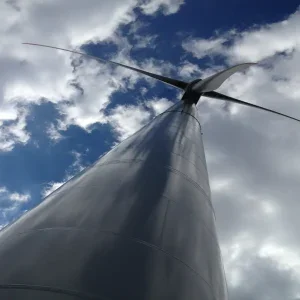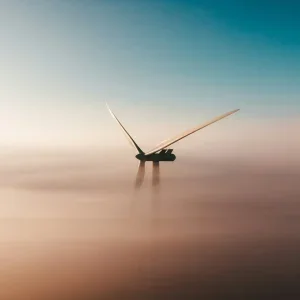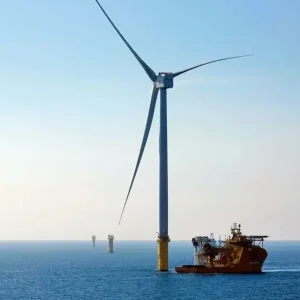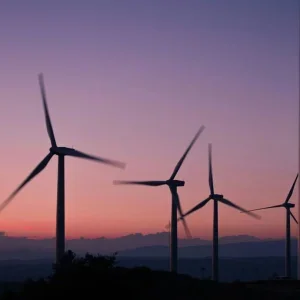With a website adorned with phrases such as ‘Let us power your career’ and ‘You own your developments’, it is clear that, at least from the outside, placing your professional development in the hands of LM Wind Power is a good career move.
Since the late 1970s, the company has been supplying blades to the renewable power sector, but the story of the company is quite remarkable and didn’t start in power at all. Lunderskov Møbelfabrik – which translates to Lunderskov Furniture Factory − was established in the 1940s to produce wooden domestic furniture. Operating out of Lunderskov in Denmark, the business grew quickly, dramatically and in a unique direction.
By the mid 1950s the company was working with new composites such as glass fibre, leading the company to split into two divisions: LM Camping and LM Glasfiber. LM Camping designed and manufactured caravans, while LM Glasfiber produced boats and an array of other glass fibre products. It was in 1978 that LM Wind Power’s wind turbine blades were first put to use in Scotland’s Orkney Islands.
Acquired by General Electric
In April of this year, General Electric (GE) completed its €1.5 billion acquisition of LM Wind Power following regulatory approval from several key markets. The move was seen as an extension of the already close working relationship between the two companies, which included the first ever installation of an offshore wind farm in the US. It brought LM Wind Power under the umbrella of the $10 billion GE Renewable Energy unit.
“The completion of the LM Wind Power acquisition provides us with the operational efficiencies necessary to support the growth of our wind turbine business, which is the fastest-growing segment of power generation,” Jérôme Pécresse, president and CEO of GE Renewable Energy, said at the time. “With LM’s technology and blade engineering, we are now able to improve the overall performance of our wind turbines, lowering the cost of electricity and increasing the value for our customers. Together, we are set to capitalise on the expansion of renewable energy and be a growth engine for GE.”
The benefits of the deal were clear for LM Wind Power too, providing it with greater access to the very latest technology and resources it needed to innovate further.
Wind turbine manufacturing is a complex process, and the construction of the blades themselves is arguably one of, if not the most, skilled elements. Anyone embarking on a career in this manufacturing sector needs to be highly skilled and have an extensive background in engineering, as Carmen Maria Alfonso Sanchez, senior manager, global training & development, at LM Wind Power, explains.
“Sometimes people think that our factories just need operators, unskilled people, but that is not true,” she says. “Our operators need to be highly skilled with a well-developed technical background.”
Sanchez has been working with LM Wind Power for the past eight years, helping to manage and train its global workforce. The company invests heavily in its people, from the recruitment phase to their very last day with the company, with professional development at the fore. This is particularly important as the company looks to hire people from a mix of backgrounds. Its number one goal, however, is to benefit the communities in which they are establishing new operations.
“The type of people we recruit is mixed,” explains Sanchez. “Sometimes we put our plants in places where industrial development may not have been as fast, but this is good for the community as we hire a lot of people from it. In some cases, they can be farmers or from other backgrounds of that kind. In other places, we can find more skilled workers with vocational training, such as electricians. Sometimes, we even find sculptors and other workers that use their hands to work, as we highly appreciate this skill too. They can do things that are really very technical. Because of the differences in the people we recruit, we have to have a global standard.”
The Turkish experience
In July of this year, the company opened its latest manufacturing facility in Bergama, Turkey. The $50-million project would, the company said, create up 450 additional skilled technical jobs for the region, ranging from manufacturing operations to technical engineering, services, administration and ancillary support. Like many other plants that have been established, LM Wind Power also designed and built a Centre of Excellence, providing on-site training facilities for current and new workers.
These centres, Sanchez explains, are crucial to the success of the plant, the company and those working for it. “When we recruit people, we take them through a six-week training process,” she explains. “It is only after that six-week process you can touch a real blade.”
During this time new employees get an understanding of the company’s culture and processes. But more importantly, given the mixed background of the new intake, trainers are able to assess different abilities and work with individuals on a oneto- one basis.
“At about the third week, you start to fit into a position,” Sanchez says. “Trainers might say ‘this guy is going to be good at the end or the beginning of the process’. Because the knowledge and skills you bring with you might be transferable to the role that you’re going to take on now, but we might not have known that in the first instance.”
She continues to say that although some positions are already predetermined, others aren’t, and so this training process is a good way of finding out how to get the best out of LM staff.
“If you go to the process, how we make blades, we have two elements; before and after the moulding,” says Sanchez. “Some things require more sensitivity with your hands while other parts require more strength because of the nature of the work. They need to grind while wearing very heavy clothing for their protection.”
Sanchez explains the nature of the roles that need to be filled, including electricians, maintenance workers, drivers and mechanics.
“Take logistics,” she says. “A blade’s physical movement is very hard work, and needs to be choreographed and planned weeks in advance. Our blades at their biggest are 88m long, so for this we need a lot of people. Transportation is a very important issue. The customer is responsible for the transportation but we need to be there to provide support. That starts at our plant. So logistics, both theory and practice, is another essential skill we require.”
The new Turkish facility, situated in the Bergama Organized Industrial Zone (BOSBI), is expected to manufacture and distribute an annual capacity of 500MW, with the capability to expand to 1.5GW. LM says it was established to address the needs of the growing Turkish renewable energy market.
A global approach
On average, LM Wind Power plants employ in the region of 700 people. The company has facilities around the world, from Canada to India and beyond. Ensuring all plants meet their standard is important, as Sanchez explains.
“One of the most important things to us is that we have a worldwide customer base,” she says. “If a client wants to buy a blade from us in China, they must have the same experience as they would when they buy a blade from Canada. We need them to know they can trust us and our products, wherever they are in the world.”
That is why the Centre of Excellence formula is so essential. With 15 plants across the globe, each centre operates to a formula, and is designed and developed to help foster a global approach. The training facilities each have a ‘dummy’ workshop and theory room. In the latter, new employees have access to the latest technology and learning materials by way of tablets, interactive screens and theory sessions, which include virtual moulding and grinding practice. The workshop is designed to represent a plant and its facilities. Here, individuals will be able to work with what are essentially waste materials, meaning any loss is already accounted for.
Once the six-week training programme has been completed new members of staff are placed in the plants, supported by a mentor. Mentors, who can be looking after two to three people at a time, are all certified to the same level, wherever they are. This helps to ensure that LM Wind Power’s global reach is based on the same local standards. But reaching those standards can sometimes be a challenge because of the substantially varied geography of LM Wind Power’s operations.
Sanchez explains how one plant offered up some unique challenges.
“There is a plant in Spain that was constructed on a hillside, a traditional countryside farming environment,” she says. “These sorts of set-ups are extremely important, but they are also difficult. If you’re [the plant] not so close to a community, then to attract high-level talents such as directors or technical engineers, the really skilled talent, can often be more difficult.”
But no challenge is too big for the global manufacturer.
An attractive proposition
Sanchez is keen to point to the attraction of LM Wind Power for potential employees, skilled or not.
“We offer opportunities for a great future for those for those with the right talent and abilities,” she says. “But people want to work for us because of our concept… for a designer or engineer our technology and the materials we use are a treasure. We are making a better world in renewable energies and that is also an attractive proposition. The product, what we do for the environment and green energy, our ambition to build a better world − all these things are attractive for skilled talent”.
And she may well be right. The Spanish plant, on the hillside, won an award for being the best local employer. And attracting skilled talent to a local community is something LM Wind Power prides itself on.
“The skilled talents we attract and develop are good for us and the local community,” states Sanchez.
The acquisition by GE won’t necessarily change the manufacturing process for LM. The company has been doing what it does for years and is good at it. But it might have a significant impact on the already strong training resources it provides.
“GE has the digital industrial approach and so our working will change,” Sanchez says. “To be able to track all the training hours we do, imagine that. Right now we cannot track things person-to-person. Can you imagine how difficult it would be to track all the individuals we recruit at that level? But with all the systems, online tools such as training materials; for me the impact GE can have for us will be huge.
“We are driven to work to excellence, through the network of plants we have, and our centres of excellence work in training people to make world-class blades.”






